Trophic level - Study guides, Class notes & Summaries
Looking for the best study guides, study notes and summaries about Trophic level? On this page you'll find 681 study documents about Trophic level.
Page 3 out of 681 results
Sort by
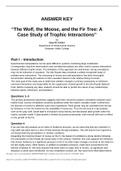
-
The Wolf, the Moose, and the Fir Tree: A Case Study of Trophic Interactions
- Exam (elaborations) • 5 pages • 2023
-
- $7.99
- 1x sold
- + learn more
ANSWER KEY “The Wolf, the Moose, and the Fir Tree: A Case Study of Trophic Interactions” by Gary M. Fortier Department of Small Animal Science Delaware Valley College Part I – Introduction Experimental manipulations can be quite difficult in systems containing large vertebrates. Consequently, long-term observations and correlational analysis are often used to assess interactions between different trophic levels. The limitations of this approach are well known; strong correlations...
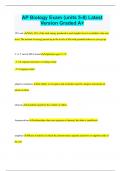
-
AP Biology Exam (units 5-8) Latest Version Graded A+
- Exam (elaborations) • 19 pages • 2024
- Available in package deal
-
- $9.99
- + learn more
AP Biology Exam (units 5-8) Latest Version Graded A+ 10% rule Only 10% of the total energy produced at each trophic level is available to the next level. The amount of energy passed up to the levels of the food pyramid reduces as you go up. 3' vs 5' end of DNA strand replication goes 3'->5' - 3' (of original molecule) is leading strand - 5' is lagging strand adaptive immunity the ability to recognize and remember specific antigens and mount an attack on them altruism ...
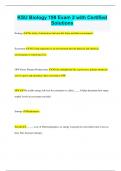
-
KSU Biology 198 Exam 2 with Certified Solutions
- Exam (elaborations) • 19 pages • 2024
- Available in package deal
-
- $9.99
- + learn more
KSU Biology 198 Exam 2 with Certified Solutions Ecology The study of interactions between life forms and their environment. Ecosystem All living organisms in an environment plus the physical and chemical environments in which they live. GPP (Gross Primary Productivity) All the sunlight that hits a given area, primary producers use it to grow and reproduce, then converted to NPP NPP The usable energy left over for consumers is called ____. It helps determine how many trophic lev...
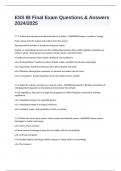
-
ESS IB Final Exam Questions & Answers 2024/2025
- Exam (elaborations) • 35 pages • 2024
-
Available in package deal
-
- $10.99
- + learn more
ESS IB Final Exam Questions & Answers 2024/2025 1.1.1 Outline the concepts and characteristics of a system - ANSWERSStorages of matter or energy. Flows- inputs into the system and outputs from the system. Processes which transfer or transform energy or matter. System- An assemblage of parts and the relationships between them which together constitutes an entity or whole. They always must contain energy, matter, and information. • Feedback mechanisms that maintain feedback and equilibr...
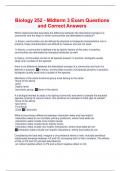
-
Biology 252 - Midterm 3 Exam Questions and Correct Answers
- Exam (elaborations) • 93 pages • 2024
-
- $20.49
- + learn more
Which statement best describes the difference between the theoretical concept of a community and the ways in which communities are delineated in practice? in theory, communities can be defined by physical or biological characteristics, but in practice, these characteristics are difficult to measure and are not used. In theory, a community is defined only by abiotic factors of the area; in practice, communities are delineated by biological attributes as well. In theory, communities consist of ...
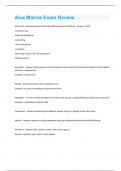
-
Aice Marine Exam Review Graded A Q&A Complete
- Exam (elaborations) • 13 pages • 2024
- Available in package deal
-
- $7.99
- + learn more
How to do a Lab-based experiment (Scientific Experiment Method) - Answer-- IV/DV -Control Group -Experimental Group -Lab setting -30 in each group -Constants -How long it took to do the experiment -Measurements Ecosystem - Answer-living organisms and the physical and chemical factors which influence them (abiotic and biotic components) Example: A rocky shore Habitat - Answer-the place where organisms live Example: the area surrounding a hydrothermal vent Population - Answer-consists...
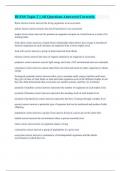
-
IB ESS Topic 2 || All Questions Answered Correctly.
- Exam (elaborations) • 6 pages • 2024
-
Available in package deal
-
- $10.32
- + learn more
Biotic factors correct answers the living organisms in an ecosystem abiotic factors correct answers the non-living factors in an ecosystem trophic level correct answers the position an organism occupies in a food chain as a result of its feeding habits food chain correct answers a simple linear relationship which shows how energy is transferred between organisms as each consumes an organism from a lower trophic level food web correct answers a group of interconnected food chains b...
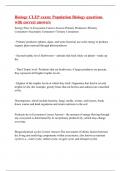
-
Biology CLEP exam: Population Biology questions with correct answers
- Exam (elaborations) • 12 pages • 2023
-
- $13.99
- + learn more
Energy Flow in Ecosystem Correct Answer-Primary Producers>Primary Consumers>Secondary Consumers>Tertiary Consumers - Primary producers (plants, algae, and some bacteria) use solar energy to produce organic plant material through photosynthesis. - Second trophic level: Herbivores—animals that feed solely on plants—make up the. - Third Tropic level: Predators that eat herbivores; if larger predators are present, they represent still higher trophic levels. - Highest of th...
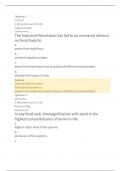
-
ENVS 1126 Test 3 (Louisiana state university)
- Exam (elaborations) • 37 pages • 2023
-
- $19.49
- + learn more
Question 1 Correct 1.00 points out of 1.00 Flag question Question text The Industrial Revolution has led to an increased reliance on fossil fuels to a. power farm machinery. b. produce irrigation pumps. c. power farm machinery and to produce fertilizers and pesticides. d. develop new types of crops. Feedback Your answer is correct. The correct answer is: power farm machinery and to produce fertilizers and pesticides. Question 2 Incorrect 0.00 points out of 1.00 Remove flag ...
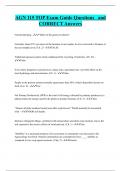
-
AGN 115 TOP Exam Guide Questions and CORRECT Answers
- Exam (elaborations) • 11 pages • 2024
- Available in package deal
-
- $8.49
- + learn more
Norman Borlaug - "father of the green revolution" Normally, about 25% (or more) of the biomass at one trophic level is converted to biomass at the next trophic level. (Ch. 2) - FALSE Traditional agroecosystems rarely emphasized the recycling of nutrients. (Ch. 23) - False Even where irrigation is practiced on a large scale, agriculture has very little effect on the local hydrology and microclimate. (Ch. 1) - False People in the poorest nations normally spend more than 20% of their dis...

Do you wonder why so many students wear nice clothes, have money to spare and enjoy tons of free time? Well, they sell on Stuvia! Imagine your study notes being downloaded a dozen times for $15 each. Every. Single. Day. Discover all about earning on Stuvia


